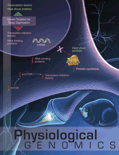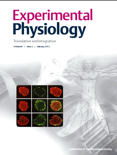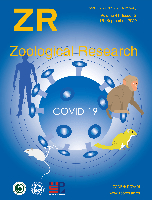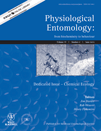
Physiological Genomics
Scope & Guideline
Unlocking the Genetic Mysteries of Physiology
Introduction
Aims and Scopes
- Genomic and Transcriptomic Analysis:
The journal frequently publishes research utilizing genomic and transcriptomic approaches to understand the molecular mechanisms underlying physiological processes, including muscle adaptation, metabolic responses, and disease mechanisms. - Physiological Responses to Environmental Changes:
Research often focuses on how organisms adapt to environmental stressors, including temperature changes, dietary variations, and hypoxia, revealing the genetic adaptations that support survival and homeostasis. - Microbiome and Host Interactions:
Studies frequently explore the role of microbiota in influencing host physiology, including immune responses, metabolic health, and disease susceptibility, highlighting the importance of host-microbiota interactions. - Comparative Physiology:
The journal encourages comparative studies across species to identify conserved and divergent physiological mechanisms, providing insights into evolutionary adaptations and species-specific traits. - Integrative Omics Approaches:
There is a strong emphasis on integrating various omics technologies (genomics, transcriptomics, proteomics, and metabolomics) to provide a holistic understanding of physiological phenomena.
Trending and Emerging
- Systems Biology Approaches:
There is a growing trend towards systems biology, integrating various omics data to understand complex physiological systems and their regulation, which is essential for comprehending multi-faceted biological responses. - Impact of Microbiome on Health:
Research focusing on the gut microbiome and its impact on metabolic health, immune function, and disease processes is rapidly increasing, highlighting the critical interplay between microbiota and host physiology. - Environmental and Stress Responses:
Emerging studies investigate how environmental changes (such as climate change) and stressors (like hypoxia and nutritional deficits) influence physiological adaptations at the genomic level. - Precision Medicine and Genomics:
There is a notable rise in research aimed at applying genomic insights to precision medicine, particularly in understanding individual variability in disease susceptibility and treatment responses. - Functional Genomics in Disease Models:
The use of functional genomics to dissect disease mechanisms and identify potential therapeutic targets is becoming increasingly prominent, especially in chronic diseases and conditions influenced by genetic factors.
Declining or Waning
- Traditional Genetic Studies:
There has been a noticeable decline in studies focusing solely on classical genetic approaches without integrating genomic technologies, as the field increasingly values comprehensive omics analyses. - Basic Physiological Mechanisms:
Research that solely investigates basic physiological mechanisms without a genomic or molecular context is becoming less common, as there is a clear trend towards studies that connect physiology with genomic insights. - Single-Factor Studies:
There is a waning interest in studies that examine single factors (e.g., one gene or one environmental stressor) in isolation, with more research now focusing on complex interactions and multifactorial analyses. - Animal Models with Limited Relevance:
The use of certain traditional animal models (e.g., less relevant rodent strains) for physiological studies is decreasing, as researchers seek models that more closely mimic human physiological conditions.
Similar Journals

Journal of Physiological Anthropology
Exploring the Science of Human Adaptation and PerformanceThe Journal of Physiological Anthropology, published by BMC, serves as a leading platform in the field of anthropological science with a strong focus on the physiological aspects of human adaptation and performance. Since its establishment in 2006, this open access journal has gained recognition for its contributions to understanding human biological variation through an interdisciplinary lens, enabling researchers and practitioners in fields such as anthropology, orthopedics, and public health to disseminate and access high-quality research. With an impressive impact factor and a classification in the Q1 quartile for Anthropology (2023), the journal holds a prominent position, ranked #29 in Social Sciences and #76 in Orthopedics and Sports Medicine according to Scopus. The journal's objectives include fostering innovative research and promoting discussions that advance knowledge on human performance, adaptation, and health in diverse environments. As a vital resource based in the United Kingdom and available freely since 2012, it opens avenues for collaboration and knowledge exchange among researchers, professionals, and students alike.

EXPERIMENTAL PHYSIOLOGY
Unveiling the science behind health through rigorous research.EXPERIMENTAL PHYSIOLOGY, published by WILEY, stands as a vital resource in the fields of Nutrition and Dietetics and Physiology, providing high-quality, peer-reviewed research since its inception in 1990. With an impressive categorization into the Q2 quartile in these domains, the journal emphasizes the integration of experimental and clinical findings, making significant contributions to our understanding of physiological processes and nutritional impacts on health. The journal operates within a competitive landscape, ranked significantly in Scopus, showcasing its relevance to both the medical community and nutritional sciences, as evidenced by its rankings in Nursing, Medicine, and Biochemistry. Though it is not currently open access, the journal remains an indispensable tool for researchers, professionals, and students seeking to deepen their knowledge and stay updated on cutting-edge research. With a publication window extending to 2024, EXPERIMENTAL PHYSIOLOGY continues to influence the academic discourse and promote advancements in its respective fields.

Physiological Reviews
Unveiling Insights, Shaping DiscoveriesPhysiological Reviews is a prestigious journal published by the American Physiological Society, dedicated to advancing our understanding of physiology across various domains. With an impressive impact factor that places it in Q1 quartiles for medicine, molecular biology, and physiology as of 2023, this journal is recognized as a leading source of high-quality reviews and research analyses. The journal has been a vital resource for the scientific community since its inception in 1945, providing in-depth and comprehensive insights that are crucial for both scholars and practitioners in the field. Although not an open-access publication, it remains widely accessible through institutional subscriptions, ensuring that crucial research findings are disseminated efficiently. With Scopus rankings that place it in the top percentile across multiple categories, Physiological Reviews continues to be an essential platform for the latest advancements and discoveries in physiology, making it indispensable for researchers, professionals, and students alike.

Acta Physiologica
Pioneering Research for a Healthier TomorrowActa Physiologica is a premier, peer-reviewed journal published by WILEY, dedicated to the dissemination of high-quality research across the field of physiology. With an impressive impact factor reflective of its Q1 category ranking in Physiology for 2023, this journal is a vital resource for researchers, professionals, and students alike, seeking to explore the complexities of biological systems. The journal is indexed with a commendable Scopus rank of #18 out of 193 in its category, placing it within the top 10% of its field, which underscores its influence and citation frequency within the academic community. Acta Physiologica publishes a variety of articles that address fundamental physiological concepts, innovative methodologies, and cross-disciplinary research. With its open access options, the journal ensures that cutting-edge knowledge is readily accessible, fostering an environment of collaboration and advancement in the study of physiology. Spanning from 2006 to 2024, the journal continues to be at the forefront of physiological research and education, encouraging the global sharing of knowledge through its comprehensive content.

INSECT MOLECULAR BIOLOGY
Exploring the Genetic Blueprint of Insect LifeInsect Molecular Biology, published by Wiley, is a leading journal dedicated to advancing the field of insect biology through molecular perspectives. With a prominent ISSN of 0962-1075 and an E-ISSN of 1365-2583, this journal has gained a significant reputation since its inception in 1992, showcasing a diverse array of research that spans across genetics, molecular biology, and specific aspects of insect science. As of 2023, it has achieved a remarkable categorization, recognized as Q1 in Insect Science and Q3 in Genetics and Molecular Biology, underscoring its pivotal role in fostering academic discourse at the intersection of biology and technology. The journal is indexed in esteemed databases with strong rankings, sitting at the 82nd percentile in Insect Science, which highlights the impactful research it publishes. While it currently does not offer open access, Insect Molecular Biology remains an essential resource for researchers, students, and professionals eager to explore the complexities of insect life at the molecular level. By disseminating innovative findings and methodologies, the journal significantly contributes to both theoretical and applied entomological research, making it a cornerstone for anyone passionate about the intricate world of insects.

COMPARATIVE BIOCHEMISTRY AND PHYSIOLOGY B-BIOCHEMISTRY & MOLECULAR BIOLOGY
Diving Deep into the Molecular Underpinnings of LifeComparative Biochemistry and Physiology B: Biochemistry & Molecular Biology, published by Elsevier Science Inc, is a premier journal dedicated to the field of biochemistry and molecular biology with a specific focus on comparative analyses across various biological systems. Since its inception in 1971, the journal has made significant contributions to our understanding of the biochemical and physiological processes that differentiate organismal function across animal and aquatic life. The journal holds a commendable position in the academic community, evidenced by its 2023 rankings, which place it in the second quartile for Animal Science and Zoology and Aquatic Science, and the third quartile for both Biochemistry and Molecular Biology as well as Physiology. Researchers and students can access cutting-edge research through this highly respected publication, which continues to influence the future of biological sciences. While currently not an Open Access journal, its rigorous peer-review process ensures that only high-quality articles are disseminated, further solidifying its role as a critical resource for professionals and academics alike seeking to explore the intricate relationships between biochemical structures and physiological functions.

ZOOLOGICAL RESEARCH
Exploring the Depths of Biodiversity and EcologyZoological Research, published by Science Press, stands as a premier open-access journal in the fields of animal science, zoology, and ecology. Since its inception in 1980, it has fostered an inclusive platform for innovative research and dialogue within the scientific community, enabling researchers from across the globe to share their findings and insights. The journal's significant impact is underscored by its classification in the Q1 quartile across multiple categories, including Animal Science and Zoology, Ecology, and Nature Conservation for 2023, as well as its impressive rankings within Scopus, placing it in the top tier of its respective fields. Situated in Beijing, China, Zoological Research not only contributes to advancing knowledge but also emphasizes the critical importance of conservation practices in today’s rapidly changing ecosystems. With its commitment to open access, researchers, educators, and students alike benefit from immediate, unrestricted access to vital scientific information, making it an essential resource for anyone involved in the biological sciences.

YEAST
Unveiling the potential of yeast in biotechnology and beyond.YEAST is a renowned peer-reviewed journal published by WILEY, dedicated to advancing the understanding of yeast biology and its applications in various scientific fields. Since its inception in 1985, YEAST has significantly contributed to the disciplines of microbiology, biotechnology, biochemistry, and genetics, achieving respectable rankings within its categories, including Q2 status in Applied Microbiology and Biotechnology and Q2 in Biotechnology as of 2023. With an emphasis on high-quality research, it explores diverse aspects of yeast organisms, from their cellular mechanisms to biotechnological applications. Although it does not currently offer an open-access option, the journal provides valuable insights and findings that are applicable to both academia and industry, making it an essential resource for researchers, professionals, and students interested in the functional and applied dimensions of yeast. With its editorial rigor and commitment to quality, YEAST continues to be a vital platform for disseminating innovative research that shapes future biotechnological advancements.

PHYSIOLOGICAL ENTOMOLOGY
Bridging Physiology and Evolution in EntomologyPHYSIOLOGICAL ENTOMOLOGY is a prestigious journal published by WILEY, focusing on the intricate relationships between physiological processes and the ecological and evolutionary dynamics of insects. With an ISSN of 0307-6962 and E-ISSN of 1365-3032, this journal has been at the forefront of insect science since its inception in 1976, contributing significantly to the understanding of insect physiology and behavior. The journal has established itself within the academic community, currently holding a position in the Q2 quartile for both Ecology, Evolution, Behavior and Systematics and Insect Science, highlighting its relevance and impact in these fields. Although there are no Open Access options available, researchers and practitioners can rely on its regular publications to stay abreast of pivotal discoveries and methodologies in insect physiology. With a commitment to advancing the field through rigorous peer-reviewed research, PHYSIOLOGICAL ENTOMOLOGY serves as an essential resource for researchers, professionals, and students alike.

Physiological Reports
Connecting Researchers to a World of Physiological DiscoveriesPhysiological Reports is a pioneering open-access journal published by WILEY, dedicated to advancing the field of physiology through the dissemination of high-quality research. Since its inception in 2013, this journal has provided a platform for innovative studies in both general physiology and medical physiology, making significant contributions to our understanding of biological processes. With an impact factor that reflects its growing influence—as evidenced by its placement in the Q2 category for physiology and medical physiology in 2023—Physiological Reports is positioned as a vital resource for researchers and practitioners alike. The journal encourages the submission of diverse studies ranging from cellular mechanisms to systemic physiology, presenting a unique opportunity for authors to reach a global audience without access barriers. It has established a reputation for rigorous peer review and timely publication, ensuring that cutting-edge research is readily available to stimulate further inquiry and collaboration in the scientific community.